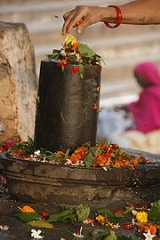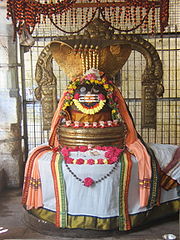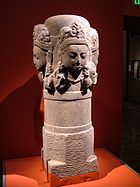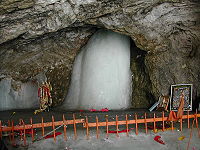
Lingam
Encyclopedia

Hinduism
Hinduism is the predominant and indigenous religious tradition of the Indian Subcontinent. Hinduism is known to its followers as , amongst many other expressions...
deity Shiva
Shiva
Shiva is a major Hindu deity, and is the destroyer god or transformer among the Trimurti, the Hindu Trinity of the primary aspects of the divine. God Shiva is a yogi who has notice of everything that happens in the world and is the main aspect of life. Yet one with great power lives a life of a...
used for worship in temples
Hindu temple
A Mandir, Devalayam, Devasthanam, or a Hindu temple is a place of worship for followers of Hinduism...
.
An interpretation suggests that the Lingam represents the beginningless and endless Stambha
Stambha
In the context of Hindu mythology, stambha, also spelt as Skambha, is believed to be a cosmic column. It is believed that the stambha functions as a bond, which joins the heaven and the earth . A number of Hindu scriptures, including the Atharva Veda, have references to stambha...
pillar, symbolizing the infinite nature of Shiva. According to another interpretation, the Lingam has also been considered a symbol of male creative energy or of the phallus
Phallus
A phallus is an erect penis, a penis-shaped object such as a dildo, or a mimetic image of an erect penis. Any object that symbolically resembles a penis may also be referred to as a phallus; however, such objects are more often referred to as being phallic...
. The lingam is often represented with the Yoni
Yoni
Yoni is the Sanskrit word for the vagina. Its counterpart is the lingam as interpreted by some, the phallus.It is also the divine passage, womb or sacred temple...
, a symbol of the goddess or of Shakti
Shakti
Shakti from Sanskrit shak - "to be able," meaning sacred force or empowerment, is the primordial cosmic energy and represents the dynamic forces that are thought to move through the entire universe in Hinduism. Shakti is the concept, or personification, of divine feminine creative power, sometimes...
, female creative energy. The union of lingam and yoni represents the "indivisible two-in-oneness of male and female, the passive space and active time from which all life originates". The lingam and the yoni have been interpreted as the male and female sexual organs since the end of the 19th century by some scholars, while to practising Hindus they stand for the inseparability of the male and female principles and the totality of creation.
Definition
The SanskritSanskrit
Sanskrit , is a historical Indo-Aryan language and the primary liturgical language of Hinduism, Jainism and Buddhism.Buddhism: besides Pali, see Buddhist Hybrid Sanskrit Today, it is listed as one of the 22 scheduled languages of India and is an official language of the state of Uttarakhand...
term लिङ्गं , transliterated as linga, has diverse meaning ranging from gender and sex to philosophic and religions to uses in common language, such as a mark, sign or characteristic. Vaman Shivram Apte's Sanskrit
dictionary provides many definitions:
- A mark, sign, token, an emblem, a badge, symbol, distinguishing mark, characteristic;
- A false or unreal mark, a guise, disguise, a deceptive badge;
- A symptom, mark of disease
- A means of proof, a proof, evidence
- In logic, the hetu or middle term in a syllogism
- In grammar, gender
- The image of a god, an idol
- One of the relations or indications which serve to fix the meaning of a word in any particular passage
- In Vedānta philosophy, the subtle frame or body, the indestructible original of the gross or visible body
- A spot or stain
- The nominal base, the crude form of a noun
- In Sāk philosophy, Pradhāna or Prakriti
- The effect or product of evolution from a primary cause and also as the producer
- Inference, conclusion
Origin
Anthropologist Christopher John Fuller conveys that although most sculpted images (murtiMurti
In Hinduism, a murti , or murthi, or vigraha or pratima typically refers to an image which expresses a Divine Spirit . Meaning literally "embodiment", a murti is a representation of a divinity, made usually of stone, wood, or metal, which serves as a means through which a divinity may be worshiped...
s) are anthropomorphic, the aniconic Shiva Linga is an important exception. Some believe that linga-worship was a feature of indigenous
Indigenous peoples
Indigenous peoples are ethnic groups that are defined as indigenous according to one of the various definitions of the term, there is no universally accepted definition but most of which carry connotations of being the "original inhabitants" of a territory....
Indian religion.
There is a hymn in the Atharvaveda
Atharvaveda
The Atharvaveda is a sacred text of Hinduism and one of the four Vedas, often called the "fourth Veda"....
which praises a pillar (Sanskrit: stambha
Stambha
In the context of Hindu mythology, stambha, also spelt as Skambha, is believed to be a cosmic column. It is believed that the stambha functions as a bond, which joins the heaven and the earth . A number of Hindu scriptures, including the Atharva Veda, have references to stambha...
), and this is one possible origin of linga-worship. Some associate Shiva-Linga with this Yupa-Stambha, the sacrificial post. In that hymn a description is found of the beginningless and endless Stambha or Skambha and it is shown that the said Skambha is put in place of the eternal Brahman
Brahman
In Hinduism, Brahman is the one supreme, universal Spirit that is the origin and support of the phenomenal universe. Brahman is sometimes referred to as the Absolute or Godhead which is the Divine Ground of all being...
. As afterwards the Yajna
Yajna
In Hinduism, yajna is a ritual of sacrifice derived from the practice of Vedic times. It is performed to please the gods or to attain certain wishes...
(sacrificial) fire, its smoke, ashes and flames, the soma
Soma
Soma , or Haoma , from Proto-Indo-Iranian *sauma-, was a ritual drink of importance among the early Indo-Iranians, and the subsequent Vedic and greater Persian cultures. It is frequently mentioned in the Rigveda, whose Soma Mandala contains 114 hymns, many praising its energizing qualities...
plant and the ox that used to carry on its back the wood for the Vedic sacrifice gave place to the conceptions of the brightness of Shiva's body, his tawny matted-hair, his blue throat and the riding on the bull of the Shiva. The Yupa-Skambha gave place in time to the Shiva-Linga. In the Linga Purâna the same hymn is expanded in the shape of stories, meant to establish the glory of the great Stambha and the supreme nature of Mahâdeva (the Great God, Shiva).
Historical period

Shaiva siddhanta

Adi Sankara summarizes the meaning of a linga in his nirvana-satakam.
I am all pervasive.
I am without any attributes, and without any form.
I have neither attachment to the world, nor to liberation (mukti).
I have no wishes for anything because I am everything,
everywhere,
every time,
always in equilibrium.
I am indeed,
That eternal knowing and bliss, Shiva,
love and pure consciousness.
The formless, genderless, attribute less source of the entire creation is called a lingam.
Sculpture
The oldest example of a lingam which is still used for worship is in GudimallamGudimallam
Gudimallam is a small village located in Srikalahasti Mandal, of the Chittoor district of Andhra Pradesh, India. It is seven miles away from Renigunta Railway Junction of considerable significance...
. According to Klaus Klostermaier, it is clearly a phallic object, and dates to the 2nd century BC. A figure of Shiva is carved into the front of the lingam.

Modern period
British missionary William WardWilliam Ward (missionary)
William Ward was an English pioneer Baptist missionary, author, printer and translator. On 10 May 1802 he was married at Serampore to the widow of John Fountain, another missionary, by whom he left two daughters.-Early life:...
criticized the worship of the lingam (along with virtually all other Indian religious rituals) in his influential 1815 book A View of the History, Literature, and Mythology of the Hindoos, calling it "the last state of degradation to which human nature can be driven", and stating that its symbolism was "too gross, even when refined as much as possible, to meet the public eye." According to Brian Pennington, Ward's book "became a centerpiece in the British construction of Hinduism and in the political and economic domination of the subcontinent." In 1825, however, Horace Hayman Wilson
Horace Hayman Wilson
Horace Hayman Wilson was an English orientalist.He studied medicine at St Thomas's Hospital, and went out to India in 1808 as assistant-surgeon on the Bengal establishment of the British East India Company....
's work on the lingayat sect of South India attempted to refute popular British notions that the lingam graphically represented a human organ and that it aroused erotic emotions in its devotees.
Monier-Williams wrote in Brahmanism and Hinduism that the symbol of linga is "never in the mind of a Saiva (or Siva-worshipper) connected with indecent ideas, nor with sexual love." According to Jeaneane Fowler, the linga is "a phallic symbol which represents the potent energy which is manifest in the cosmos." Some scholars, such as David James Smith, believe that throughout its history the lingam has represented the phallus; others, such as N. Ramachandra Bhatt, believe the phallic interpretation to be a later addition. M. K. V. Narayan distinguishes the Siva-linga from anthropomorphic representations of Siva, and notes its absence from Vedic
Vedic
Vedic may refer to:* the Vedas, the oldest preserved Indic texts** Vedic Sanskrit, the language of these texts** Vedic period, during which these texts were produced** Vedic pantheon of gods mentioned in Vedas/vedic period...
literature, and its interpretation as a phallus in Tantric
Tantra
Tantra , anglicised tantricism or tantrism or tantram, is the name scholars give to an inter-religious spiritual movement that arose in medieval India, expressed in scriptures ....
sources.
Ramakrishna
Ramakrishna
Ramakrishna , born Gadadhar Chattopadhyay , was a famous mystic of 19th-century India. His religious school of thought led to the formation of the Ramakrishna Mission by his chief disciple Swami Vivekananda – both were influential figures in the Bengali Renaissance as well as the Hindu...
practiced Jivanta-linga-puja, or "worship of the living lingam". At the Paris Congress of the History of Religions in 1900, Ramakrishna's follower Swami Vivekananda
Swami Vivekananda
Swami Vivekananda , born Narendranath Dutta , was the chief disciple of the 19th century mystic Ramakrishna Paramahansa and the founder of the Ramakrishna Math and the Ramakrishna Mission...
argued that the Shiva-Linga had its origin in the idea of the Yupa-Stambha
Stambha
In the context of Hindu mythology, stambha, also spelt as Skambha, is believed to be a cosmic column. It is believed that the stambha functions as a bond, which joins the heaven and the earth . A number of Hindu scriptures, including the Atharva Veda, have references to stambha...
or Skambha—the sacrificial post, idealized in Vedic ritual as the symbol of the Eternal Brahman
Brahman
In Hinduism, Brahman is the one supreme, universal Spirit that is the origin and support of the phenomenal universe. Brahman is sometimes referred to as the Absolute or Godhead which is the Divine Ground of all being...
. This was in response to a paper read by Gustav Oppert, a German Orientalist
Oriental studies
Oriental studies is the academic field of study that embraces Near Eastern and Far Eastern societies and cultures, languages, peoples, history and archaeology; in recent years the subject has often been turned into the newer terms of Asian studies and Middle Eastern studies...
, who traced the origin of the Shalagrama-Shila and the Shiva-Linga to phallicism. According to Vivekananda, the explanation of the Shalagrama-Shila as a phallic emblem was an imaginary invention. Vivekananda argued that the explanation of the Shiva-Linga as a phallic emblem was brought forward by the most thoughtless, and was forthcoming in India in her most degraded times, those of the downfall of Buddhism
Buddhism
Buddhism is a religion and philosophy encompassing a variety of traditions, beliefs and practices, largely based on teachings attributed to Siddhartha Gautama, commonly known as the Buddha . The Buddha lived and taught in the northeastern Indian subcontinent some time between the 6th and 4th...
.
According to Swami Sivananda
Swami Sivananda
Swami Sivananda Saraswati was a Hindu spiritual teacher and a proponent of Yoga and Vedanta. Sivananda was born Kuppuswami in Pattamadai, in the Tirunelveli district of Tamil Nadu. He studied medicine and served in Malaya as a physician for several years before taking up monasticism...
, the view that the Shiva Lingam represents the phallus is a mistake; The same sentiments have also been expressed by H. H. Wilson in 1840. The novelist Christopher Isherwood
Christopher Isherwood
Christopher William Bradshaw Isherwood was an English-American novelist.-Early life and work:Born at Wyberslegh Hall, High Lane, Cheshire in North West England, Isherwood spent his childhood in various towns where his father, a Lieutenant-Colonel in the British Army, was stationed...
also addresses the interpretation of the linga as a sex symbol. The Britannica encyclopedia entry on lingam also notes that the lingam is not considered to be a phallic symbol;
Wendy Doniger
Wendy Doniger
Wendy Doniger is an American Indologist and Mircea Eliade Distinguished Service Professor of the History of Religions at the University of Chicago Divinity School, the Department of South Asian Languages and Civilizations, and the Committee on Social Thought...
, an American scholar of the history of religions, states:
However, Professor Doniger clarified her viewpoints in a later book, The Hindus: An Alternative History, by noting that some texts treat the linga as an aniconic pillar of light or an as an abstract symbol of God with no sexual reference and comments on the varying interpretations of the linga from phallic to abstract.
According to Hélène Brunner, the lines traced on the front side of the linga, which are prescribed in medieval manuals about temple foundation and are a feature even of modern sculptures, appear to be intended to suggest a stylised glans, and some features of the installation process seem intended to echo sexual congress. Scholars like S. N.Balagangadhara have disputed the sexual meaning of lingam.
Naturally occurring lingams

Amarnath
Located in the Indian state of Jammu and Kashmir and situated on Mount Amarnath, the Amarnath caves are one of the most famous shrines in Hinduism. Dedicated to the god Shiva, the shrine is said to be over 5,000 years old...
in the western Himalayas forms every winter from ice dripping on the floor of a cave and freezing like a stalagmite
Stalagmite
A stalagmite is a type of speleothem that rises from the floor of a limestone cave due to the dripping of mineralized solutions and the deposition of calcium carbonate. This stalagmite formation occurs only under certain pH conditions within the underground cavern. The corresponding formation on...
. It is very popular with pilgrims.
Shivling
Shivling (Garhwal Himalaya)
Shivling is a mountain in the Gangotri Group of peaks in the western Garhwal Himalaya, near the snout of the Gangotri Glacier. It lies in the northern Indian state of Uttarakhand, south of the Hindu holy site of Gaumukh . Its name refers to its status as a sacred symbol of the God - Lord Shiva's...
(6543m) is also a mountain in Uttarakhand
Uttarakhand
Uttarakhand , formerly Uttaranchal, is a state in the northern part of India. It is often referred to as the Land of Gods due to the many holy Hindu temples and cities found throughout the state, some of which are among Hinduism's most spiritual and auspicious places of pilgrimage and worship...
(the Garwhal region of Himalayas). It arises as a sheer pyramid above the snout of the Gangotri Glacier
Gangotri Glacier
Gangotri Glacier is located in Uttarkashi District, Uttarakhand, India in a region bordering China. This glacier, source of the Ganges, is one of the largest in the Himalayas with an estimated volume of over 27 cubic kilometers. The glacier is about 30 kilometres long and 2 to 4 km wide...
. The mountain resembles a Shiva linga when viewed from certain angles, especially when travelling or trekking from Gangotri to Gomukh as a part of a traditional Hindu pilgrimage.
See also
- Axis mundiAxis mundiThe axis mundi , in religion or mythology, is the world center and/or the connection between heaven and Earth. As the celestial pole and geographic pole, it expresses a point of connection between sky and earth where the four compass directions meet...
- BanalingaBanalingaBanalinga, a stone found in nature, in the bed of the Narmada river in Madhya Pradesh state, India, is an aniconic symbol of worship, based on either the scriptures or cultural traditions among the Hindus, particularly of the Shaivaites and Smartha Brahmins. Stones are ancient and connote divinity...
- DandaDandaIn the Devanāgarī script, the danda is a punctuation character. The glyph consists of a single vertical stroke. The character can be found at code point U+0964 in Unicode. The "double danda" is at U+0965 . ISCII encodes danda at 0xEA....
- DhyanalingaDhyanalingaThe Dhyanalinga is a Yogic temple located from Coimbatore, India. The temple was consecrated by Sadhguru Jaggi Vasudev, a yogi and mystic. The temple is consecrated using prana prathista and is dedicated for meditation. Silence is maintained inside the temple. Dhyana in the Sanskrit language,...
- Hindu iconographyHindu iconographyOver the millennia of its development Hinduism has adopted several iconic symbols, forming part of Hindu iconography, that are imbued with spiritual meaning based on either the scriptures or cultural traditions. The exact significance accorded to any of the icons varies with region, period and...
- LingayatismLingayatismLingayatism, also known as Veerashaivism, is a distinct Shaivite denomination in India. It makes several departures from mainstream Hinduism and propounds monotheism through worship centered on Lord Shiva. It also rejects the authority of the Vedas and the caste system. The adherents of this faith...
- MukhalingamMukhalingamMukhalingam or Srimukhalingam is a village panchayat in Jalumuru mandal of Srikakulam district, Andhra Pradesh, India.-Geography:Mukhalingam is located at...
- Pancharamas
- SaligramSila (murti)Shila, Shila, Shila, (शिला in Devanagari, in IAST refers to a Vaishnava (Hindu) aniconic representation of Vishnu, in the form of a spherical, usually black-coloured stone found in the sacred river Gandaki....
Further reading
}}- Versluis, Arthur (2008), The Secret History of Western Sexual Mysticism: Sacred Practices and Spiritual Marriage, Destiny Books, ISBN 978-1-59477-212-2

